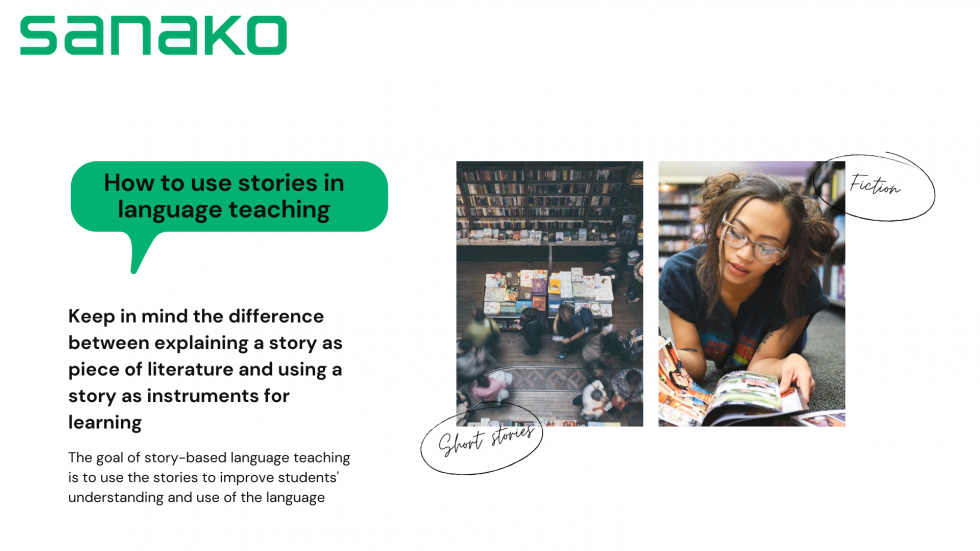Stories have never been so topical. In fact, nowadays storytelling is an extremely popular concept, the stepping stone of so many communication strategies both in politics and business.
Storytelling, however, is not only a tool in the hands of political strategists or marketers. Indeed, stories can be extremely useful in education and in particular in language teaching. In this article we want to illustrate the power of storytelling within English and foreign language lessons and how telling a compelling, fascinating story will help your students to improve in their language learning process.
What is a story-based language teaching method?
According to Harmer & Puchta (2018), as described in their book “Story-based Language Teaching”, stories motivate students and they create a special classroom atmosphere in which students can connect emotionally better to the learning content and new vocabulary. Probably it is exactly this emotional link why stories also have an impact on how much students can remember from the lesson. As the popular saying goes: “people don’t remember facts and figures, they remember the stories“.
The perks of storytelling-based language teaching
Stories are one of the oldest tools of communication. They are also among the most effective to the extent that, through emotional involvement, they are able to stimulate the attention and the memory of the listener. As such, they provide an invaluable teaching instrument.

Early studies on the relationship between storytelling and language teaching focused on how stories supported children’s language learning. In the case of English language teaching, for example, research highlighted that:
In fact, as teacher Claire Venable notes, some of the features of children’s stories are actually useful to facilitate language learning. Elements such as the use of simple language, rhymes, the presence of illustrations that guide the understanding of the story, stimulate the acquisition of new vocabulary.
Nevertheless, building a lesson around a story also offers educational advantages for adult language learning as well. Indeed, storytelling has the advantage of encouraging the listener to actively reconstruct the meaning of the told story. This process stimulates reflective and creative thinking and the construction of mental images.
In other words, stories trigger activities that are fundamental in the language learning process.
“Stories are effective as educational tools because they are believable, memorable, and entertaining. The believability stems from the fact that stories deal with human-like experience that we tend to perceive as an authentic and credible source of knowledge.”
Choosing the right story to tell
If we want to use stories as a real didactic tool in the language classroom, then it is necessary to keep in mind some criteria for the selection of the tales to be used in class.
As some studies have underlined, the tale should be meaningful and engaging first of all for the teacher.
On the other hand, the story should also be functional to the students’ level of preparation and their different learning styles.
It is equally important to choose stories that can help students acquire new language structures, especially in view of a practical use of the language. Therefore, a good solution is to choose texts by contemporary authors so that students can learn new words and idiomatic expressions in an authentic way.
How can you build a language teaching unit around a story?
Using a story as the building block for a teaching unit allows you to develop different types of language learning activities to break the class routine.
As has been noted, there are a number of exercises that can be developed from telling a story.
- Pre-reading activities
- While-reading activities
- Post-reading activities
So, are you tempted to introduce storytelling into your language lessons? If you need further inspiration, you can find a practical demonstration of storytelling in the video below which will confirm how the fascinating power of stories can capture the attention of your students.

Interested to try this language teaching method with your students? Check out this blog post to find out how you can use Sanako Connect platform for creating and assigning short audio-book narration tasks and other story-based learning activities for your students.
Resources used in this article:
A. Davis, Storytelling in the Classroom: Enhancing traditional oral skills for teachers, Paul Chapman Publishing.
C. F. Pinto, Using Children’s literature in ELT. A story-based approach, in Sensos, 2/2012.
C. Venable, Teaching young learners: How to use stories in the classroom, in One Stop English.
L. Forrest, Story-based Language Teaching, in Modern English Teacher.
V. Boris, What Makes Storytelling So Effective for Learning?, in Harvard Business Review.
J. Harmer & Puchta, H., (2018) Story-based Language Teaching: The Resourceful Teacher Series, Helbling Verlag GmbH.

